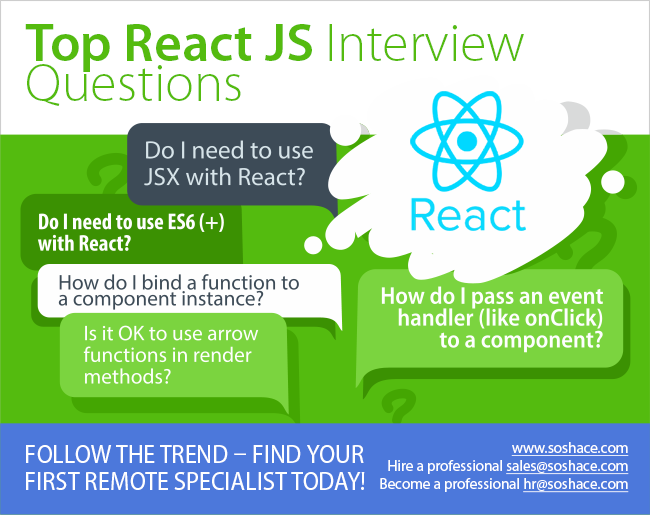No need to say how difficult It is to find a professional React JS developer. The hiring process usually takes several stages, including skype interview and testing. In this article, we will review the most relevant React JS interview questions with the answers.
Question 1: Please give a definition to the React JS. React JS is a JavaScript library which is being used for building user interfaces.
Question 2: How can I make an AJAX call? You can use any 3rd party libraries with React JS for this, like Axios or use ES6 Fetch.
Question 3: Where in the component lifecycle should you make an AJAX call? If a developer has to do data populating with AJAX calls, he should do it in the componentDidMount lifecycle method.
Question 4: Do you need to use JSX with React? This technology is being used by default but it’s optional.
Question 5: Do you need to use ES6 (+) with React? This technology is being used by default but it’s optional.
Question 6: How can a developer prevent a function from being called too many times in a row or too quickly? If a user has an event handler as onScroll or onClick and wants to avoid the callbacks from being fired too quickly, then he/she can limit the rate at which a callback is being executed. A user can do execute this by means of throttling (sample changes which are based on frequency (eg _.throttle), debouncing (publishing changes after a period of passivity (eg_.debounce), requestAnimationFrame throttling (changes of the sample based on requestAnimarionFrame (eg raf-sch).
Question 7: What a setState is doing? It is scheduling a components state object update. If state changes, the component re-renders.
Question 8: What is the difference between props and state? Both state and props (shortened for “properties”) are plain JavaScript objects. Their main difference includes the fact that props get passed to the component, similar to the parameter function while the state is being managed within the component, similar to the variables described within a function. Both hold information that influences the output of render.
Question 9: Why setState gives the wrong value? Both this.state and this.props represents the rendered values, which are currently on the screen. Calls to setState can be named asynchronous. It means that you should not expect this.state reflect the new value instantly after calling setState. Calls to setState are asynchronous – don’t rely on this.state to reflect the new value immediately after calling setState. Pass an updater function instead of an object if you need to compute values based on the current state (see below for details).
Question 10: How a developer can update state with values, depending on the current state? A developer can pass a function or an object to setState to make sure that the call is constantly using the latest version of the state.
Question 11: What is the difference between a function in setState or passing an object? Passing an update function can allow a user to get access to the current state value inside the updater. As long as setState calls are being batched it may let you complete chain updates and make sure they are being built on the top of each other without any conflict.
Question 12: How can a developer bind a function to the component instance? A developer can use several ways in order to make sure that the functions have the correct access to the component attributes like this.props and this.state, which for sure depends on the syntax and initial steps which were used during the process of web development:
- Use Arrow Function in Render onChange={e => this.handleChange(e)}.
- Bind in Constructor.
constructor(props) {super(props);this.handleChange = this.handleChange.bind(this);} - Use Arrow Function in Class Property handleChange = () => {// call this function from render // and this.whatever in here works fine.}.
Question 13: How does a user can pass an event handler (like onClick) to the component? A developer can pass event handlers as well as the other functions as props to the child components. If a developer needs an access to the parent component in the handler, he needs to bind the function to the component instance.
Question 14: Explain what is CSS-in-JS pattern? CSS-in-JS is a pattern, where CSS is being composed by means of JavaScript instead of being defined in external files. This pattern is not a part of React and is being provided by other libraries because React has no attitude on how to define styles.
Question 15: Can a developer create animations in React? No doubt, ReactJS can be easily used for powering animations.
Question 16: Is there any officially recommended way of structuring React projects? React has no officially recommended way of structuring the projects. It means that React has no opinion on how a developer should put files into folders. Although, there are several common approaches, which can be used by professional developers (grouping by features or routes, grouping by file type, avoiding too much nesting, avoiding overthinking).
Question 17: What is the Virtual Dom? The virtual Dom is the programming concept when a virtual representation of a UI is being stored in the memory and synchronized why the real DOM. Programmers call this process reconciliation. This concept helps to enable declarative React API, where a user tells React what state he/she wants the UI to be in, and React makes sure the DOM matches the expected state. This excludes the attribute manipulation, handling of events, and manual updating of the DOM that a developer would have to use otherwise. In React JS, this term “virtual DOM” is mainly being associated with the React elements since they are the objects, which represent the UI. React on the other hand is using internal objects “fibers” to store additional information about the component tree.
Question 18: What is the difference between the Shadow DOM and the Virtual DOM? They are, for sure, different. The Shadow DOM is a browser technology, which is being mainly used for scoping variables and CSS in the web components, as long as the Virtual DOM is a concept which is being implemented by the JavaScript libraries on top of the browser APIs.
We are looking forward to meeting you on our website soshace.com










